Serviços Personalizados
Journal
Artigo
Indicadores
-
 Citado por SciELO
Citado por SciELO
Links relacionados
-
 Similares em
SciELO
Similares em
SciELO  uBio
uBio
Compartilhar
Boletín de la Sociedad Argentina de Botánica
versão On-line ISSN 1851-2372
Bol. Soc. Argent. Bot. vol.52 no.4 Córdoba dez. 2017
FITOQUÍMICA
Nutrient content of woody species in the Patagonian steppe, Argentina
Mabel Barría1, Martina Crettón1,2, Celeste Gurín1, María Elena Arce3, Enrique Rost4 and Marcia Mazzuca1,2*
1 Departamento de Química.
2 CIT Golfo San Jorge - CONICET.
3 Departamento de Biología, Facultad de Ciencias Naturales.
4 Departamento de Ingeniería Química. Facultad de Ingeniería. Universidad Nacional de la Patagonia San Juan Bosco, km. 4. 9000 Comodoro Rivadavia. Chubut, Argentina.
* Corresponding author. EM: mazzucam@unpata.edu.ar
Summary
Woody plants constitute a vital food reserve for the herbivores inhabiting the Patagonian steppe. In a preliminary study, some of these plants showed a high content of ether extract (FAT). To determine whether the low availability of nitrogen in soils leads to low forage quality and whether a high FAT content correlates with a high amount of nutritive lipids, namely fatty acids (FA), chemical parameters of forage quality of aerial parts of thirteen woody plants from this steppe were analyzed. Plants showed moderate or low crude protein (CP) content, and, independently of the FAT content, all samples had approximately the same total content of FA (TFA), with an average of 1% of dry matter. The highest CP content was found in aerial parts of Atriplex lampa (13%), Atriplex sagittifolia (10%), Adesmia salamancensis (10%) and seeds of Retanilla patagonica (22%). This parameter and the values of digestibility (DMD) defined these four species as those with best forage quality. Except for A. lampa and Berberis microphylla, which have been previously studied in other regions of Argentina, this is the first report on the nutritional quality of woody species from the Patagonian steppe.
Key words: Fatty acids; Proximal analysis; Woody plants.
Resumen
Contenido de nutrientes de especies leñosas en la estepa patagónica, Argentina
Las plantas leñosas constituyen una reserva vital de alimentos para herbívoros que habitan la estepa patagónica. Estudios preliminares mostraron alto contenido en materia soluble en éter (FAT) en varias de ellas. Para conocer si la baja disponibilidad de nitrógeno de los suelos conduce a una baja calidad de forraje y si el alto contenido en FAT se corresponde con una alta cantidad de ácidos grasos (FA), se analizaron parámetros químicos de calidad del forraje de partes aéreas de trece especies nativas patagónicas. Las plantas mostraron un contenido en proteínas crudo (CP) moderado a bajo. Independientemente de su contenido en FAT, todas las muestras presentaron aproximadamente el mismo contenido en FA totales con un promedio del 1% en materia seca. El mayor contenido en CP fue en las partes aéreas de Atriplex lampa (13%), Atriplex sagittifolia (10%), Adesmia salamancensis (10%) y en las semillas de Retanilla patagonica (22%). Este parámetro y los valores de digestibilidad (DMD) definen a estas cuatro especies como las de mejor calidad forrajera. A excepción de A. lampa y Berberis microphylla, las cuales han sido previamente estudiadas en otras regiones de Argentina, éste constituye el primer reporte sobre calidad nutricional de partes aéreas de especies leñosas patagónicas.
Palabras clave: Ácidos grasos; Análisis proximal; Plantas leñosas.
Introduction
The Patagonian steppe is a natural ecosystem with cool temperate weather and average annual temperature of 12 °C. The region is characterized by dry westerly winds with greater intensity in spring-summer and rainfall regime in autumn-winter. Rainfall does not exceed 200 mm per year (Paruelo et al., 1998). The soils are poor in organic matter and nitrogen (del Valle, 1998; Valenzuela et al., 2011).
The native herbivores that inhabit this steppe such as guanacos have the ability to eat woody plants (San Martin & Bryant, 1989; Puig et al., 1996; Pelliza et al., 2004). Most Patagonian woody plants are endemic and play an important role, especially when the herbaceous vegetation is exhausted by the cold or drought (Frayssinet et al., 2007; Pelliza et al., 1997, Silva Colomer & Passera, 1990; Correal Castellanos et al., 1986). Some studies have reported the existence of alkaloids in aereal parts of Berberis microphylla (syn. B. buxifolia) (Fajardo et al., 1979; Manosalva et al., 2014) and oxalic acid in leaves of Atriplex lampa (Fernández et al., 1999), which act as antinutrients. There is also some nutritional information of A. lampa (Fernandez et al., 1999) and fruits of Berberis heterophylla (Mazzuca et al., 2005). However, the nutritional value of the rest of the plants included in this study remains unknown. In a preliminary work, some of these species showed high ether extract (FAT) content (Barría et al., 2012), whereas in another study, high amounts of seco-chiliolidic acid and several terpenoids were isolated from fresh parts of Nardophyllum bryoides (Sanchez et al., 2010). This last kind of substances is generally synthesized by plants in response to biological and environmental situations. Although these compounds are lipids, they have no nutritional value (Martinez Marin et al., 2010; Palmquist & Jenkins, 2003). Physical situations such as hydric stress may also be unfavorable for processes such as biological nitrogen fixation, especially in leguminous plants (Golluscio et al., 2006).
Under the hypotheses that the low availability of nitrogen in the soils leads to low forage quality and that a high FAT content does not imply high amount of nutritive lipids (FA), in the present study, we evaluated the quality of forage of thirteen woody shrub species from Argentine Patagonia taking into account the following parameters: dry matter (DM), moisture, ash, crude protein (CP), ether extract (FAT), acid detergent fiber (ADF), lignin (ca), cellulose, dry matter digestibility (DMD), metabolizable energy (ME), and fatty acid content (FA). These species were selected based on previous reports about the diets of herbivores in the San Jorge Gulf District (Candia et al., 1995; Puig et al., 1996; Pelliza et al., 2004; Ciari & Nakamatsu, 2006). The species studied are also important in ethnobotany (Ladio & Rappapport, 1999; Richeri et al., 2013), pharmacology (Sánchez et al., 2010; Mendiondo et al., 2000; Agnese et al., 1986; Ruiz et al., 2010) and as sources of natural products with some other interesting biological activities (Pérez et al., 2014; Siless et al., 2013).
The data obtained will hopefully contribute to the knowledge of arid ecosystems, and may provide nutritional information to be taken into account during actions of management and preservation of native resources.
Materials and Methods
Plant material
The scientific and common names of the plants and families studied, as well as the time of geographical location and the parts of the plants collected are shown in Table 1. The collection time of each plant coincided with the period of greatest consumption by herbivores (Pelliza, 1997). According to field observations (Arce, 2008), browses from a variable number of young plants (between 10 and 15) were randomly collected. Voucher specimens were identified and deposited in the Patagonia Regional Herbarium under the numbers listed in Table 1.
Table 1. Plant material, common and scientific names and families, collected part of the plants, time of collection and location.
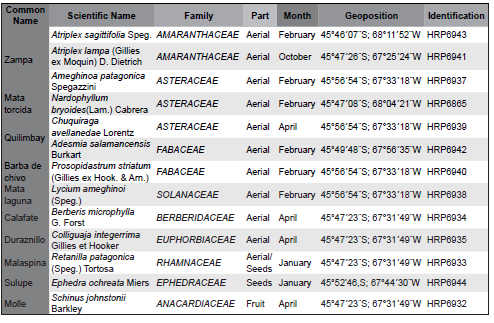
Sample preparation
A portion of fresh samples (approximately 10 g each sample) was immediately separated for moisture determination. The remaining material was dried at room temperature in a cool, dry and semi-dark place. In those cases in which the drying process caused the separation of stems from leaves, these were analyzed separately. Once dried, the samples were mechanically ground in a mill with a 1-mm screen and stored in glass jars in cool and darkness until analysis.
Proximal analysis
The parameters evaluated were: dry matter (DM), moisture, ash, crude protein (CP), ether extract (FAT), acid detergent fiber (ADF), lignin (ca), cellulose, dry matter digestibility (DMD), metabolizable energy (ME), and fatty acids (FA) content. DM was determined from moisture data according to the AOAC methodology (Official Methods of Analysis, 1990), CP according to AOAC 955.04 and 954.01, ashes by ignition to 550 ◦C (AOAC 942.05), FAT by Soxhlet with ethyl ether:hexane 1:1 (AOAC 963.15) and ADF and acid detergent lignin (ADLsa) according to AOAC 973.18. ADF was expressed exclusive of residual ash (ADFom). Cellulose was calculated as the difference between ADF and lignin. ME (MJ kg–1 DM) was calculated from the expression ME = 10.67 + 0.116 (CP) + 0.243 (FAT) – 0.155 (ADF) (Van der Bosch et al., 1997). Digestibility was calculated from ADF analysis on the basis of the expression: DMD = 88.9 – 0.779 * (% ADF) (Di Marco, 2011).
Fatty acid composition
For the analysis of FA, total lipids were transesterified according to Lepage & Roy (1986) with acetyl chloride in methanol 1:20 v /v. After the reaction, the tubes were cooled in water and the reaction mixture was diluted with 1 mL water and extracted three times with 1 mL hexane. The hexane phase was dried under a nitrogen stream at atmospheric pressure and at room temperature. FA as fatty acid methyl esters (FAME) were resuspended with 100 μL hexane for injection in a Hewlett-Packard 5890 gas chromatographer with a flame ionization detector. A capillary column Varian Factor Four VF-23ms (30 m x 0.25 mm x 0.25 μm; Varian INC Lake Forest, CA, USA) was used. Hydrogen was used as a carrier gas. The injection split was set at 25/1. The temperature in the column was held at 120°C for 1 min, then increased to 10°C/min up to 160°C (ramp 1), and finally increased to 3°C/min up to 200°C (ramp 2). The injector and detector temperatures were 240°C and 260°C, respectively. Determinations were carried out in triplicate. A standard of FAME (Supelco Inc., Supelco Park, Bellfonte, USA) was run under identical conditions to identify compounds on the basis of their retention times. FA were quantified using heptadecanoic acid (C17:0) as internal standard. Thus, an aliquot of 125 μg heptadecanoic acid dissolved in 5 μL toluene was added to the biological samples before transesterification. Quantitative data for FA content represent the mean of three independent experiments.
Statistical analysis
The results are presented as mean ± standard deviation of determinations for triplicate samples.
Results
Proximal analysis
The values obtained for DM, CP, FAT, ash content, ADFom, ADL(sa), cellulose, DMD and ME are shown in Tables 2 and 3. In general, stems had lower CP content than leaves. Aerial parts had moderate (9 -13%) or low (lower than 8%) CP content, being Atriplex lampa (13%) the richest and Chuquiraga avellanedae (5%) the poorest in this parameter. A. lampa also grows in the central western region of Argentina, and has been previously studied because of its utility as feed for extensive livestock (Correal Castellanos et al., 1986; Silva Colomer & Passera, 1990; Fernandez et al., 1999; Ruiz et al., 2002). The CP content for A. lampa was similar to that reported by other authors in the same season of collection (Correal Castellanos et al., 1986). FAT content was very high in leaves of Nardophyllum bryoides (28%) and in the aerial parts of Ch. avellanedae (11%). FAT content was also high in leaves of Ameghinoa patagonica (6%) and Adesmia salamancensis (5%). Ash content was high in several plants, and was generally richer in leaves than in stems, with Atriplex species with the highest content (22%). These results are in agreement with that previously reported by several authors, who agree with the fact that the most outstanding features for the genus Atriplex are the high CP and mineral content (Van de Baan, 2008; Gihad et al., 1994). Likewise, the values for humidity and DM for both species of Atriplex are in agreement with the published range for the genus (Van der Baan, 2008).
Table 2. Proximal composition of Patagonian woody plants. Aereal (A), Leaves (L), stems (St), seeds (S); Fruits (F). Dry matter (DM) expressed as g/kg fresh weight basis. Crude protein (CP), ether extract (FAT), ash, ADFom, as g/kg DM+DS: standard deviation (n=3).
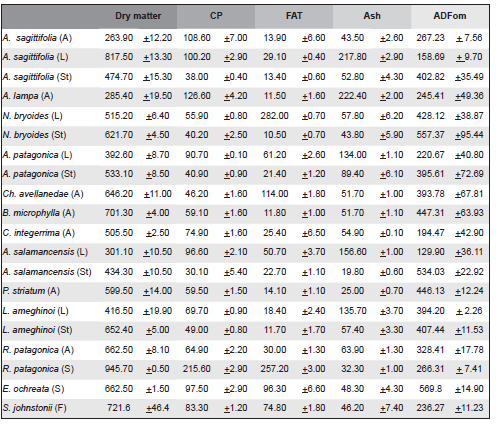
Table 3. Lignin, cellulose, dry matter digestibility (DMD) and metabolizable energy (ME) of Patagonian woody plants. Aereal (A), Leaves (L), stems (St), seeds (S), Fruits (F). Lignin (sa), cellulose and DMD are expressed as g/kg DM +SD: standard deviation (n=3). ME is expressed as MJ/kg DM. N.A. not analyzed.
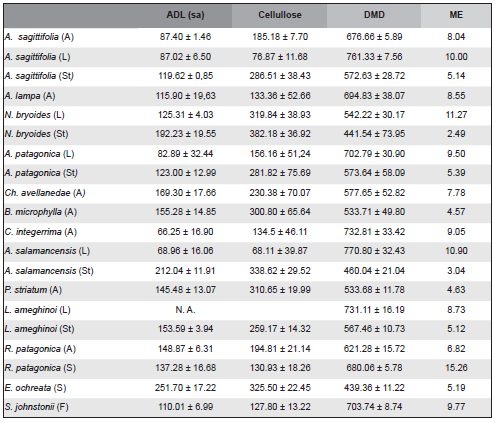
The ADFom value was generally higher in stems than in leaves, with the lowest values for leaves of A. salamancensis and Atriplex sagittifolia (13 % and 16% respectively). The ADFom value of aerial parts was higher in B. microphylla and P. striatum with 56 and 45%, respectively, whereas the ADFom of A. lampa (24%) was similar to that previously reported for the central west region of 1986; Silva Colomer & Passera, 1990; Fernandez et al., 1999; Ruiz et al., 2002). The CP content for A. lampa was similar to that reported by other authors in the same season of collection (Correal Castellanos et al., 1986). FAT content was very high in leaves of Nardophyllum bryoides (28%) and in the aerial parts of Ch. avellanedae (11%). FAT content was also high in leaves of Ameghinoa patagonica (6%) and Adesmia salamancensis (5%). Ash content was high in several plants, and was generally richer in leaves than in stems, with Atriplex species with the highest content (22%). These results are in agreement with that previously reported by several authors, who agree with the fact that the most outstanding features for the genus Atriplex are the high CP and mineral content (Van de Baan, 2008; Gihad et al., 1994). Likewise, the values for humidity and DM for both species of Atriplex are in agreement with the published range for the genus (Van der Baan, 2008).
The ADFom value was generally higher in stems than in leaves, with the lowest values for leaves of A. salamancensis and Atriplex sagittifolia (13 % and 16% respectively). The ADFom value of aerial parts was higher in B. microphylla and P. striatum with 56 and 45%, respectively, whereas the ADFom of A. lampa (24%) was similar to that previously reported for the central west region of Argentina (Correal Castellanos et al., 1986; Silva Colomer et al., 1990). In contrast, our samples had higher cellulose content than lignin content (13 and 12% respectively) for the same season of collection (Correal Castellanos et al., 1986). The stems of N. bryoides and A. salamancensis showed the highest levels of ADFom (56 and 54% respectively), and cellulose (38 and 34% respectively). DMD is a parameter that depends on the ADF value. The lower the ADF value, the higher the DMD of the plant. Thus, for leaves of A. salamancensis and A. sagittifolia, DMD values were 77 and 76% respectively. The highest ME values were found in the leaves of N. bryoides (11.3 MJ/kg) and A. salamancensis (11.0 MJ/kg). The lignin content of the leaves analyzed was similar to that reported for woody plants from arid regions of western Africa (Breman et al., 1995). Our results also showed that, in general, the content of cellulose was higher than that of lignin.
In seeds, the highest content of CP (22%) and FAT (26%) and thus the highest ME (16.0 MJ/kg) was that of Retanilla patagonica. Although there are no reports about CP values for seeds of forage shrubs in the Patagonian region to compare our value, it is in the range of the values reported by the Food and Agriculture Organization of the United Nations (FAO) for seeds of Prosopis tamarugo (27%). The FAT content of R. patagonica was higher than that of other Patagonian forage seeds like Prosopis denudans (4%), Prosopis alpataco (7%) (Mazzuca & Balzaretti, 2003), Prosopidastrum globosum (5%) (Ravetta et al., 1998), Berberis heterophylla (7%), and Berberis buxifolia (8%) (Mazzuca et al., 2005), and lower than that of seeds of Colliguaja integerrima (35%) (Ravetta et al., 1991).
Compared with the fruits and seeds analyzed, the fruits of Schinus johnstonii had the lowest value of ADF (24 %) and lignin (11%) and, consequently, the highest DMD (70%).The CP and FAT of Schinus johnstonii were higher than that for Berberis species (Andola et al., 2011).
Fatty acids (FA)
The results of the FA analysis from aerial parts, leaves and stems are shown in Tables 4 and 5. The leaves generally showed higher TFA content than the stems, with a mean of 12.56 and 8.24 g/kg DM respectively. Independently of the FAT content, the amount of TFA was almost similar in all the samples (Figure 1). Thus, while leaves of N. bryoides, A. patagonica and Ch. avellanedae had very different FAT content, their TFA content was very similar (11.53, 13.60, and 13.59 g/kg DM, respectively). It is interesting to note that the aerial parts of Berberis microphylla showed both very low contents of FA and FAT. In general, aerial parts showed higher content of saturated fatty acids (SAFA), with palmitic acid (C16:0) as the highest. However, the stems of A. sagittifolia, A. lampa and A. patagonica had behenic acid (22:0) as the main FA, and the stems of A. salamancensis had lignoceric acid (24:0) as the main FA. The main monounsaturated fatty acid (MUFA) was in general oleic acid (18:1). As an exception, the stems of Lycium ameghinoi showed palmitoleic acid (16:1) as the main FA. Seeds generally showed higher amount of FA than aerial parts (Table 6), with oleic acid (18:1) as the predominant MUFA and linoleic acid (18:2) as the predominant polyunsaturated FA (PUFA). The highest FA content was found in R. patagonica seeds. In fruits of S. johnstonii, the main FA was the alpha linoleic acid (18:2) (Table 6).
Table 4. Chemical composition of FAME (mg/kg DM) from aerial parts of A. sagittifolia, A. lampa, N. bryoides, A. patagonica and Ch. avellanedae. Total fatty acids (TFA). Total saturated fatty acids (ƩSAFA); total monounsaturated fatty acids (ƩMUFA), total polyunsaturated fatty acids (ƩPUFA).
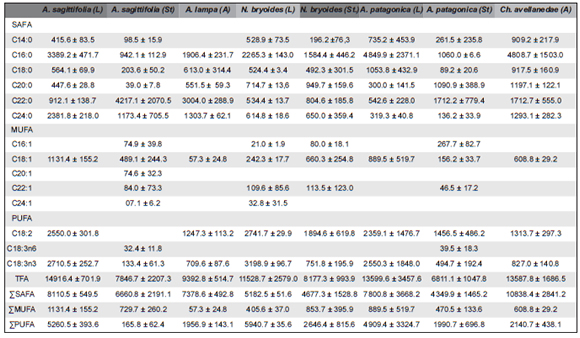
Table 5. Chemical composition of FAME (mg/kg DM) from aerial parts of B. microphylla, C. integerrima, A. salamancensis, P. striatum, L. ameghinoi and R. patagonica. Aerial (A); Leaves (L); Stems (St). Total fatty acids (TFA). Total saturated fatty acids (ƩSAFA); total monounsaturated fatty acids (ƩMUFA), total polyunsaturated fatty acids (ƩPUFA).

Table 6. Chemical composition of FAME (mg/kg DM) from seeds of R. patagonica, E. ochreata and fruits of S. johnstonii. Seeds (S), fruits (F). Total fatty acids (TFA). Total saturated fatty acids (ƩSAFA); total monounsaturated fatty acids (ƩMUFA), total polyunsaturated fatty acids (ƩPUFA).
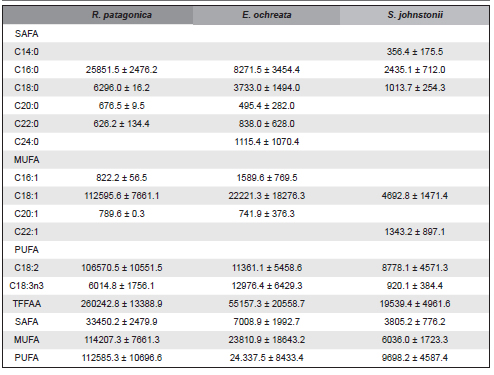
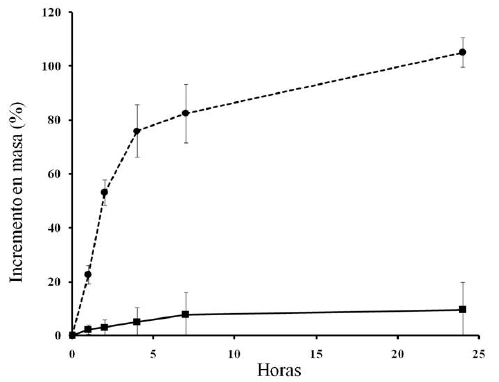
Fig. 1. Relationship between FAT, expressed as ether extract (EE g/kg of DM) and total fatty acids (TFA) expressed as g/kg of DM.
Discussion
From a nutritional point of view, the CP content is one of the most important parameters. Our results showed that, in general, these plants do not have high CP content. The highest CP contents were detected in Atriplex spp, A. salamancensis and A. patagonica. A. salamancensis belongs to the Leguminosae, a family characterized by high CP in their leaves, with an average of 18% (Hacker et al., 1981). Although there are no reports from other woody species of Adesmia, the CP content in this species (10%) was lower than that reported for herbaceous species of this genus (Cuevas et al., 2012; Sheffer- Basso et al., 2001, Nakamatsu et al., 2011, Vileta et al., 2014). As reported by Goluscio et al. (2006) for Adesmia volckmannii, hydric stress may also contribute to the low CP content because it may limit the biological fixation of nitrogen in this species. A low CP content was also found in Prosopidastrum striatum, which also belongs to the family Leguminosae.
It is known that, in general, the FAT content of the vegetative structures of woody plants is lower than 1% of DM and rarely higher than 5% (Kramer & Kozlowski, 1979), and that the quantitatively important FAT for the feeding of herbivores are FA.
Our results showed a very high FAT content in the leaves of N. bryoides (28%), Ch. avellanedae (11%), and A. patagonica (6%). In this sense, it is remarkable that for all the species analyzed, independently of the amount of FAT, the TFA of aerial parts, leaves and stems was approximately in the same order, with a mean value of 1% of DM. These results are in agreement with those reported by Palmquist (1996), who indicated that the FA concentration in forages rarely exceeds 1.5% of DM. Regarding the quality of FA, we observed that aerial parts, stems and leaves generally had a relatively high proportion of SAFA, with a prevalence of palmitic (C16:0) and stearic (18:0) acids. It is known that the digestibility of SAFA depends, in part, on the chain length, and that 16:0 and 18:0 FA are more digestible than FA with longer chains (Palmquist, 1996). Our results showed that the stems of A. salamancensis and A. sagittifolia had high content of lignoceric (C24:0) and behenic (C22:0) acids, respectively. These long- chain FA may probably come from waxes synthesized to prevent dehydration.
The parameter ME describes the energy availability for the animal and depends on the CP, FAT and ADF contents of the plant. The mean ME for maintenance for all aerial browse species was 6.9 MJ/kg DM. This value is similar to that found for browse species in the arid rangelands of the northwest of Argentina (Van der Bosch et al., 1997). For seeds, the value was quite higher (13.0 MJ/kg DM). At this point, it is important to emphasize that, in the case of samples with high FAT content, the calculations of ME could lead to overestimations. As previously described, N. bryoides had a very high ME content at expenses of the high FAT content, and this is not representative of the FA content. A similar situation was observed in the aerial parts of Ch. avellanedae and the leaves of A. patagonica.
Ash contents were variable, with the highest values for the genus Atriplex. ADFom represents the compounds of the cellular wall: cellulose and lignin. In agreement with the finding of Diagayeté, 1981 (cited by Breman et al., 1995), we found that lignin concentrations were higher for total browse than for foliage, because of the high lignin concentrations in twigs.
The DMD as well as CP are parameters that define the quality of a forage species (Di Marco, 2011). It is considered that high-quality forage contains approximately 70% of DMD and more than 15% of CP. The samples of L. ameghinoi, C. integerrima and A. patagonica had good DMD values but very low CP content. Thus, considering both parameters, the samples with better forage quality are the leaves of A. salamancensis and Atriplex sagittifolia, and the seeds of R. patagonica.
We concluded that the woody species analyzed that naturally grow in the low-nitrogen soils of the Argentine steppe have low CP content. This lowers the forage quality. On the other hand, the presence of high amount of FAT in some of the samples does not mean that there is a proportionally high content of TFA. This last value was approximately constant in all samples. This fact should be considered when estimating ME, especially when the FAT amount of vegetative parts of plants exceeds 5% of FAT.
The moderate or poor quality of the aerial parts of woody species here described also supports the adaptation of native herbivores such as guanacos, described by several authors to have higher efficiency in digestion than true ruminants.
Acknowledgments
This work was supported by grants from UNPSJB (PI 939, 2012-2015), ANPCyT (PICT1414 - 2014), and PIO CONICET-UNPSJB 15320150100010CO. We thank Gabriela Perez for her help in the filtrate of fibers.
Bibliography
1. AGNESE, A. M., C. A. CHIALER & H. R. JULIANI. 1986. Two new flavonoids from Prosopidastrum globosum. J. Nat. Prod. 49: 528-529. [ Links ]
2. A.O.A.C.,1990. Official Methods of Analysis, Association of Official Analytical Chemist. [ Links ]
3. ANDOLA, H. C., R. S. RAWAL & I. D. BHATT. 2011. Comparative studies on the nutritive and anti-nutritive properties of fruits in selected Berberis species of West Himalaya, India. Food Res. Int. 44: 2352-2356. [ Links ]
4. ARCE, M. E. 2008. Entrevista personal. [ Links ]
5. BARRÍA, M., M. CRETTÓN, S. MISCORIA, M. MAZZUCA & M. E. ARCE. 2012. Composición centesimal de especies vegetales patagónicas de uso forrajero J. Arg. Chem. Soc. 99:1-2. [ Links ]
6. BREMAN, H. & J. J. KESSLER. 1995. Woody plants in agro-ecosystems of semi-arid regions (with an emphasis on the Sahelian countries). Advanced Series in Agricultural Sciences. Springer, Berlin, Heidelberg, New York [ Links ]
7. CANDIA, R. & A. D. DALMASSO. 1995 Dieta del guanaco (Lama guanicoe) y productividad del pastizal en la reserva La Payunia, Mendoza (Argentina). Multequina. 4: 5-15. [ Links ]
8. CIARI, G. & V. NAKAMATSU. 2006. Flora de la región extraandina del noroeste del Chubut. INTA EEA Esquel. Available in: http://www.produccion-animal.com.ar/produccion_y_manejo_pasturas/pasturas_naturales_especies/13-Noroeste_Chubut.pdf. [Access 12/04/2017]. [ Links ]
9. CORREAL CASTELLANOS, E., J. SILVA COLOMER & J. P. C. BOZA LÓPEZ. 1986. Valor nutritivo de cuatro arbustos forrajeros de género Atriplex (A. nummularia , A. cynerea , A. undulata y A. lampa). Pastos 16: 177-189. [ Links ]
10. CUEVAS, M. F., R. A. OJEDA, M. A. DACAR & F. M. JAKSIC. 2012. Seasonal variation in feeding habits and diet selection by wild boars in a semi-arid environment of Argentina, Acta Theriol. 58: 63-72. [ Links ]
11. DEL VALLE H. F. 1998. Patagonian soils: a regional synthesis. Ecología Austral 8:103-123. [ Links ]
12. DI MARCO O. 2011. Estimación de la calidad de los forrajes, Producir XXI, 20: 24-30. Available in: www.produccion-animal.com.ar/tablas_composicion_alimentos/45-calidad.pdf. [Access 12/04/2017]. [ Links ]
13. FAO http://www.fao.org/docrep/006/AD314S/AD314S09.htm [Access 12/04/2017]. [ Links ]
14. FAJARDO V., A. URZÚA, R. TORRES & B. K. CASSELS. 1979. Metabolitos secundarios de Berberis buxifolia. Rev. Latinoamer. Quím. 10: 131- 134. [ Links ]
15. FERNÁNDEZ, S. S., A. P. PADILLA & S. MUCCIARELLI. 1999. Protein extraction from Atriplex lampa leaves: potential use as forage for animals used for human diets. Plant Foods Hum. Nutr. 54: 251-259. [ Links ]
16. FRAYSSINET, N., E. GONZÁLEZ, A. M. AMBROGIO, I. FURLAN & S. FERNÁNDEZ. 2007. Estudio citológico, exo y endomorfológico en Atriplex lampa (Moq.) D. Dietr. (Chenopodiaceae). Polibotánica 24: 1-23. [ Links ]
17. GIHAD, E. A. & H. M. EL SAHER. 1994. Utilization of halophytes by livestok on rangelands, problems and prospects. In: SQUIRES, V. & A. T. AYOUB (eds.), Halophytes as a resource for livestock and for rehabilitation of degraded lands, pp 77-96. Springer Science and Business Media B. V., Dordrecht. [ Links ]
18. GOLLUSCIO R., A. FAIGÓN & M. TANKE. 2006. Spatial distribution of roots and nodules, and δ15N evidence of nitrogen fixation in Adesmia volckmanni, a Patagonian leguminous shrub. J. Arid Environ. 67: 328–335.
19. HACKER, J. B. & D. J. MINSON. 1981. The digestibility of plant parts. Herbage abstracts 51: 459-482. [ Links ]
20. KRAMER, P. & T. KOZLOWSKI. 1979. Cap. 8 Lipid, Terpenes and related substances, in Physiology of woody plants, pp 290. Academic Press, London. [ Links ]
21. LADIO, A. & E. RAPAPPORT.1999. El uso de las plantas silvestres comestibles en poblaciones suburbanas del noroeste de la Patagonia. Parodiana 11:49-62. [ Links ]
22. LEPAGE G. & C. C. ROY. 1986. Direct transesterification of all classes of lipids in a one-step reaction. J. Lipid Res. 27: 114–120.
23. MANOSALVA, L., A. MUTIS, J. DÍAZ, A. URZÚA, V. FAJARDO & A. QUIROZ 2014. Identification of isoquinoline alkaloids from Berberis microphylla by HPLC ESI-MS/MS. Bol. Latinoam. Caribe Plant. Med. 13: 324-335. [ Links ]
24. MARTÍNEZ MARÍN, A. L., M. PÉREZ HERNÁNDEZ, L. PÉREZ ALBA, G. GÓMEZ CASTRO & D. CARRIÓN PARDO. 2010. Metabolismo de los lípidos en los rumiantes. REDVET. 11:1-21. Available in: http://www.veterinaria.org/revistas/redvet/n080810.html [Access 12/04/2017]. [ Links ]
25. MAZZUCA, M., S. A. MISCORIA, E. ROST & V. T. BALZARETTI. 2005. Fatty acids and sterols in seeds from wild species of Berberis in argentine Patagonia. J. Arg. Chem. Soc. 93:241-246. [ Links ]
26. MAZZUCA, M. & V. T. BALZARETTI. 2003. Fatty acids, sterols and other steroids from seeds of patagonian Prosopis species. J.Sci. Food Agr. 83: 1072-1075. [ Links ]
27. MENDIONDO, M. E., B. E. JUAH REZ & P. SEELIGMANN. 2000. Flavonoid profiles of some Argentine species of Chuquiraga (Asteraceae). Biochem. Syst. Ecol. 28: 283-285. [ Links ]
28. NAKAMATSU, V., G. BUONO, N. ELISSALDE & J. ESCOBAR. 2011. Specific Quality Index of plant species in Patagonia, Argentina. Proceedings from the 9th International Rangelands Congress, FAO AGPC, pp 409. Rome. [ Links ]
29. PALMQUIST, D. 1996. Utilización de lipidos de las dietas de rumiantes. REBOLLAR, P. G., G.G. MATEOS & C. DE BLAS (eds.). In XII curso Especialización Avances en Nutrición y Alimentación Animal Fundación española para el desarrollo de la nutrición animal, Madrid. [ Links ]
30. PALMQUIST, D. L. & T. C. JENKINS, T. C. 2003. Challenges with fats and fatty acids methods. Journal of Anim. Sci. 81: 3250-3254. [ Links ]
31. PARUELO, J.-M., A. BELTRÁN, E. JOBBÁGY, O. E. SALA, & R. A. GOLLUSCIO. 1998. The climate of Patagonia: General patterns and controls on biotic processes. Ecol. Austral 8: 85-101. [ Links ]
32. PELLIZA SBRILLER, A. & D. V. SARASQUETA. 2004. Choiques: Plantas forrajeras preferidas. Carpeta técnica 12/04 INTA. Bariloche. Available in: http://inta.gob.ar/sites/default/files/script-tmp-miscelaneas_04.pdf. [Access 12/04/2017]. [ Links ]
33. PELLIZA SBRILLER, A., P. WILLEMS, V. NAKAMATSU & A. MANRO. 1997. Atlas dietario de herbívoros patagónicos. In: SOMIO R. (ed.), Prodesar - INTA - GTZ: Bariloche, Bariloche. [ Links ]
34. PÉREZ, M., M. GARCÍA, M. SÁNCHEZ, M. STUPAK, M. MAZZUCA, J. A. PALERMO & G. BLUSTEIN. 2014. Effect of secochiliolide acid isolated from the Patagonian shrub Nardophyllum bryoides as active component in antifouling paints Int. Biodeter. Biodegr. 89: 37-44. [ Links ]
35. PUIG, S., F. VIDELA, S. MONGE & V. RPIG. 1996. Seasonal variations in guanaco diet (Lama guanicoe Müller 1776) and food availability in Northern Patagonia, Argentina. J. Arid Environ. 34: 215-224. [ Links ]
36. RAVETTA, D. A. & A. SORIANO. 1998. Alternatives for the development of new industrial crops for Patagonia. Ecol. Austral 8:297-307. [ Links ]
37. RAVETTA, D. A., A. SORIANO & P. CATTANEO. 1991. Colliguaya integerrima (Euphorbiaceae): its seed oil, residual meal, and propagation. Econ. Bot. 45:288-290. [ Links ]
38. RICHERI M., A. H. LADIO & A M. BEESKOW. 2013. Conocimiento tradicional y autosuficiencia: la herbolaria rural en la Meseta Central del Chubut (Argentina). Bol. Latinoam. Caribe Plant. Med. 12: 44-58. [ Links ]
39. RUIZ, M. B., G. FERESIN & A. TAPIA. 2002 Aptitud forrajera de Atriplex lampa (Moquin) Dietrich y Atriplex numularia (Lindl) Chenopodiaceae. EEA INTA-San Juan e Instituto de Biotecnología UNSJ. Available in: http://inta.gob.ar/documentos/aptitud-forrajera-de-atriplex-lampa-moquin-dietrich-y-atriplex-nummularia-lindl-chenopodiaceae [Access: Januar 2017]. [ Links ]
40. RUIZ A., I. HERMOSÍN- GUTIÉRREZ, C. MARDONES, C. VERGARA, E. HERLITZ, M. VEGA, C. DORAU, P. WINTERHALTER, & D. VON BAER. 2010. Polyphenols and Antioxidant Activity of Calafate (Berberis microphylla) Fruits and Other Native Berries from Southern Chile. J. Agric. Food Chem., 586081:6089. [ Links ]
41. SAN MARTIN, F. & F. C. BRYANT. 1989. Nutrition of domesticated South American llamas and alpacas. Small Rumin. Res. 2: 191–216.
42. SÁNCHEZ, M., M. MAZZUCA, M. J. VELOSO, L. R. FERNÁNDEZ, G. SILESS, L. PURICELLIC & J. A. PALERMO. 2010. Cytotoxic terpenoids from Nardophyllum bryoides. Phytochem. 71: 1395-99. [ Links ]
43. SHEFFER – BASSO, S. M., A. V. AVILA JACQUES, M. DALL’AGNOL, J. RIBOLDI & S. M. JESUZ CASTRO. 2001. Disponibilidade e Valor Nutritivo de Forragem de Leguminosas Nativas (Adesmia DC.) Exóticas (Lotus L.) R. Bras. Zootec. 30: 975-982.
44. SILESS, G. E., E. LOZANO, M. SÁNCHEZ, M. MAZZUCA, M. SOSA & J. A. PALERMO. 2013. Secochiliolide acid and some semi-synthetic derivatives affect the in vitro growth of Trypanosoma cruzi epimastigotes. Bioorg. Med. Chem. Let. 23: 4964-4967. [ Links ]
45. SILVA COLOMER, J. & C. B. PASSERA. 1990. The nutritional value of Atriplex spp. as fodder for arid regions. J. Arid Environ. 19: 289–295.
46. VAN DER BAAN, A. 2008. The determination of digestibility of Atriplex nummularia cv. De Kock with different techniques. Department of Animal and Wildlife Sciences, Faculty of Natural and Agricultural Science, University of Pretoria, Pretoria. Available in http://repository.up.ac.za/bitstream/handle/2263/25996/dissertation.pdf?sequence=1 [Access: 12/04/2017]. [ Links ]
47. VAN DER BOSCH, S., J. C. GUEVARA, F. M. TACCHINI & O. R. ESTEVEZ. 1997. Nutrient content of browse species in the arid rangelands of the Mendoza plain, Argentina. J. Arid Environ. 37: 285-298. [ Links ]
48. VALENZUELA, M. F., I. P. CASTRO, M. E. ARCE & M. OCAMPO. 2011. Propiedades físicas y químicas de suelos con Acantholippia seriphioides (tomillo) en los alrededores de Comodoro Rivadavia. Actas Segundo Congreso Nacional de Ecología y Biología de Suelos. Mar del Plata. Bs. As. [ Links ]
49. VILETA, D. G., M. GROSSO & M. FONDEVILA. 2014. Nutritive value for ruminants of two herbaceous South American native legumes: Adesmia bicolor and Adesmia macrostachya. Anim. Prod. Sci. 54, 158–164.
Recibido el 25 de enero de 2017,
aceptado el 26 de abril de 2017.














